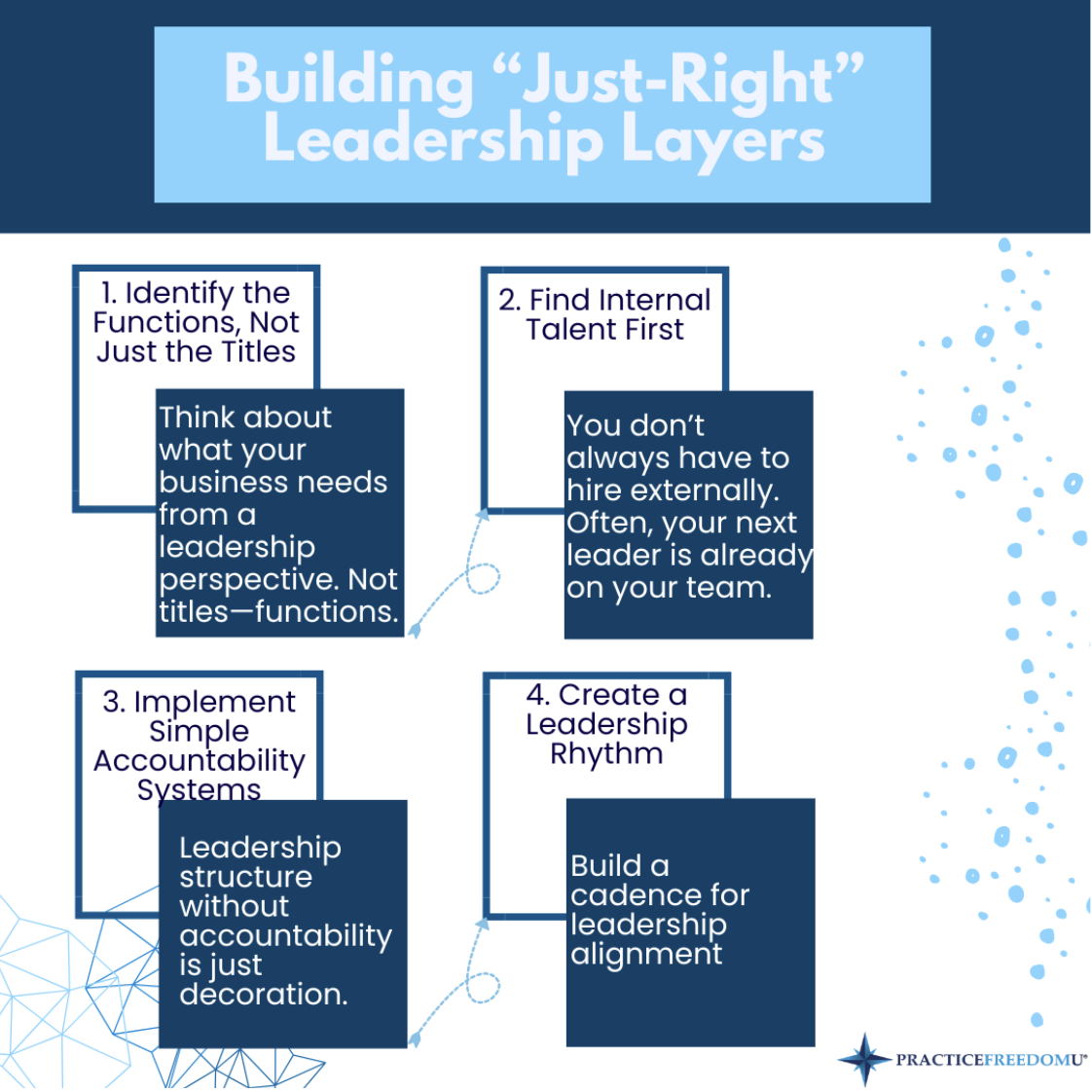There comes a moment in nearly every successful private practice when growth starts to feel… heavy.
You’re no longer a startup scrapping for patients, but you’re not a corporate machine with layers of leadership, airtight systems, and a full executive team either.
You’re somewhere in the middle.
And in that “middle,” things get messy.
You’re too big to manage everything yourself… but too small to afford—or even properly utilize—a full management structure.
Sound familiar?
This is one of the most painful and confusing stages of private practice growth. It’s where many owners get stuck. And without the right leadership strategy, this phase can become a permanent ceiling rather than a temporary transition.
Let’s talk about what’s really going on—and how to lead your practice through this growth bottleneck.
The Leadership Gap No One Warned You About
When you first started, everything flowed through you.
You hired. You trained. You handled the books. You saw patients. You made it all work.
But now? You have multiple clinicians, an admin team, and maybe even a second or third location. The complexity has exploded, but your leadership structure hasn’t evolved to match it.
You’re left holding the bag—managing team issues, putting out fires, answering a thousand questions a day—and wondering why you’re exhausted.
This is the leadership gap.
It’s the point where your business has outgrown “owner-led everything” but hasn’t yet built the management layers needed to take the load off your plate.
And unless addressed, this gap creates a cascade of problems:
- Team confusion and underperformance
- Bottlenecks in decision-making
- Owner burnout
- Slowed growth—or worse, regression
The truth is, you can’t scale your private practice without leadership infrastructure. But most owners don’t know how to build it, especially when it feels like there’s no budget or bandwidth to do so.
The Real Reason Delegation Isn’t Working
Many owners try to “delegate more” to fix this.
But here’s the hard truth: delegation without structure isn’t leadership, it’s just chaos with a different name.
You might find yourself handing off tasks to your most capable team member (“Hey Sarah, can you take care of this for me?”), but without clear roles, expectations, or authority, it just creates confusion. (Harvard Business Review)
Here’s what often happens:
- The team member doesn’t fully know what’s expected.
- They do their best, but things fall through the cracks.
- You jump back in to fix it.
- Trust erodes. You feel even more overwhelmed.
- Rinse. Repeat.
It’s not their fault. It’s not yours either. It’s a structural issue.
The missing piece? Defined leadership roles and accountability systems that grow with your business.
The Trap of Waiting “Until You Can Afford It”
Many owners know they need more leadership help—practice managers, team leads, maybe even a COO someday—but they talk themselves out of it.(Entrepreneur)
“I can’t afford to bring on another salary.”
“What if I hire someone and they don’t work out?”
“We’re not big enough for that yet.”
So they wait. And while they wait, they grind harder. They pick up more slack. They do their best to hold everything together.
But here’s the truth: You can’t afford to keep doing everything yourself.
There’s a hidden cost to staying in this in-between zone:
- Slower growth
- High staff turnover
- Owner burnout
- Inconsistent patient experience
- Missed opportunities
The longer you delay building a leadership structure, the more you risk stalling your practice’s momentum.

So What’s the Answer? Build “Just-Right” Leadership Layers
You don’t need a bloated org chart or a six-figure executive hire tomorrow.
You just need to start where you are, with the right people, in the right roles, with the right expectations.
Here’s how:
1. Identify the Functions, Not Just the Titles
Think about what your business needs from a leadership perspective. Not titles—functions.
Do you need someone to:
- Manage the clinical team?
- Oversee front desk and patient flow?
- Handle hiring and onboarding?
- Monitor KPIs and performance?
- Lead meetings and accountability?
Make a list of these leadership functions. This gives you clarity on what’s missing—and where you’re carrying too much yourself.
2. Find Internal Talent First
You don’t always have to hire externally. Often, your next leader is already on your team.
Look for team members who:
- Consistently demonstrate responsibility and initiative
- Communicate well and earn the trust of others
- Understand your values and patient care philosophy
Instead of promoting them into vague “manager” roles, give them clear ownership of specific functions with measurable outcomes. (Entrepreneur)
Example: Instead of “Front Desk Lead,” assign them “Patient Experience Manager” with metrics like average wait time, number of schedule errors, and front desk retention.
3. Implement Simple Accountability Systems
Leadership structure without accountability is just decoration.
Start with basic systems:
- Weekly check-ins with each leader/owner of a function
- Scorecards with 3–5 key metrics per role
- Quarterly goals tied to team performance
You don’t need fancy software—just a Google Sheet and consistent follow-through.
4. Create a Leadership Rhythm
Build a cadence for leadership alignment:
- Monthly leadership meetings
- Quarterly strategic reviews
- Annual planning retreats (even if it’s just a day away from the office)
This creates the space to think strategically, solve issues proactively, and keep everyone rowing in the same direction.
You Don’t Need to Do It Alone
Building leadership infrastructure is one of the highest-leverage moves you can make—but it’s also one of the hardest.
Not because it’s complicated… but because it forces you to shift your identity.
From being the doer of all things to the builder of people and systems.
From being the expert in your business to the visionary for your business.
That’s not an easy leap to make—especially when your days are already full.
That’s why I coach practice owners through this exact transition. We help you identify what leadership layers you need, who’s ready to step up, and how to build the accountability to make it work.
Because once you make this shift, everything gets easier:
- Your team becomes more engaged and effective
- You get your time and energy back
- Your business grows without constantly needing you
- You finally step into the role of CEO, not chief everything officer
Growth Requires Structure
The problems you’re experiencing aren’t because you’re doing something wrong—they’re because you’ve grown.
But growth without structure eventually collapses under its own weight.
If you’re too big to manage everything but too small to build a traditional executive team, you’re in the messy middle.
And that’s okay.
The solution isn’t to wait until things get easier. The solution is to build a leadership structure that fits where you are now and can grow with you into the future.
At Practice Freedom U, we specialize in helping private practice owners like you build the leadership structure and business systems you need to grow, without the stress and overwhelm. Through coaching, community, and proven frameworks, we guide you step by step so you’re no longer stuck in the weeds of daily operations. Whether you’re ready to develop your next leaders, delegate with confidence, or finally create a business that runs without depending entirely on you, Practice Freedom U is here to support your next level of growth.
You don’t need more hustle. You need more leadership. Let’s build it together.Want help designing your leadership structure and scaling your private practice with clarity and confidence?
Let’s talk. Schedule a free strategy call and discover how to grow your business without burning out.
————————————————————-
Are you ready for a coach? Join the hundreds of physical therapy owners who are building the practice of their dreams with the support, guidance and direction of a Practice Freedom U Coach. Take the first step towards creating a business that sets you free by scheduling a Discovery Call



